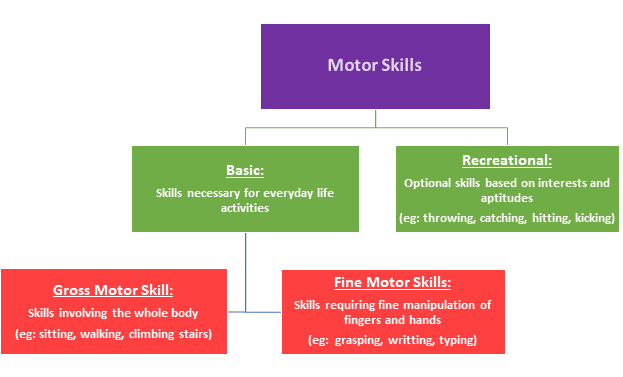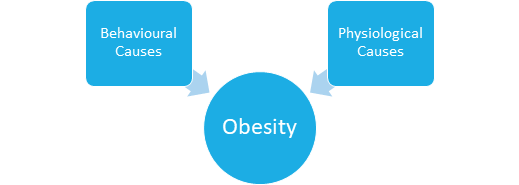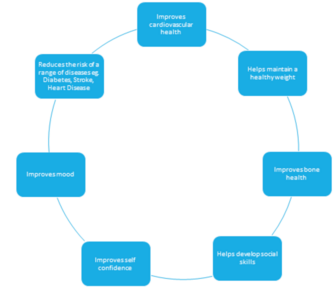Down Syndrome Developmental Milestones and Physical Activity
Developmental Milestones in Children with Down Syndrome[edit | edit source]
From the time a child is born, they grow and learn at their own pace. However, some skills are expected to be mastered around a specific age. These are called developmental milestones. Milestones can be physical achievements, language-related, or social accomplishments.[1]
The ability to move is essential to human life and development. All children begin developing a wide range of movement skills, or motor skills, starting at birth. These motor skills are wide-ranging and often broken down into the sub-sections below:
Persons with DS will generally achieve the same basic motor skills necessary for everyday living and personal independence, however, it may be at a later age and with less refinement compared to those without DS.[2] Some adjusted milestones for DS are available below:
While these milestones are generally agreed upon, studies targeting developmental milestones tend to only examine a small number of people. This makes the information less representative of the entire DS population. Researchers also commonly compare people with DS to their non-DS counterparts of the same age. This is an invalid comparison, and it would be more correct to compare children with DS to non-DS individuals of the same mental age. Despite these limitations, the above-listed milestones are widely used and considered accurate.[4]
Reduced Levels of Physical Activity[edit | edit source]
The research on physical activity levels in people with Down syndrome is conflicting. However, most research does find people with DS live highly sedentary lives and they do not achieve the recommended guidelines for physical activity levels.[5][6] The daily recommended levels of physical activity for children is at least 60 minutes of moderate to vigorous-intensity activity, and for adults the recommended levels is at least 150 minutes of moderate aerobic activity each week, including at least two strength session in the week.[7][8] Although people with DS may have decreased capacity for exercise compared to their peers without DS, the guidelines clearly state that children with DS should still meet the recommended guidelines or do as much physical activity as they can manage.[9]
Furthermore, as people with DS age, their physical activity levels fall even further behind their peers without DS.[5][10][11] This trend demonstrates that reduced activity levels are a lifelong issue for children with DS that must be addressed.
Barriers to Physical Activity[edit | edit source]
Most individuals with DS have to overcome social and environmental barriers to access physical activity. People with DS face many obstacles with the main barriers being lack of money, transportation, access to programmes and support from family and carers. It is commonly thought that people with DS are too fragile to participate in exercise.[12]
Poor strength and balance are limitations to both cardiovascular and resistance exercise. However, this needs to be addressed as many individuals with DS are now being classed as obese. Individuals with Down syndrome have been found to have substantially higher rates of obesity compared to the general population.[13] Often occurring early on in childhood, obesity was found to remain stable from childhood into adulthood, with slight increases after puberty.[14] Obesity is now recognised as a major health risk for people with Down syndrome.[15]
The causes of obesity in the Down syndrome population can be divided into physiological causes and behavioural causes. Physiological causes may include conditions such as hypothyroidism, decreased metabolic rate, increased leptin levels (a hormone which helps regulate hunger), short stature and low levels of lean body mass.[16] Behavioural tendencies such as negative thinking and inattention behaviour may become barriers that prevent vital dietary and lifestyle changes to occur.[16]
Physical inactivity also increases the chance for the development of other health problems such as diabetes, increased blood pressure, dyslipidaemia, early markers of cardiovascular disease, musculoskeletal disorders, breathing difficulties with worsening of sleep apnea and psychological effects including reduced quality of life [7][16].
Aerobic fitness in both youth and adults with Down syndrome is reduced compared to their peers without DS [17][18]. Studies find that adolescents and young adults with DS have comparable aerobic fitness to non-DS older adults (60years +) with heart disease [18]. They also have lessened aerobic abilities, reduced muscular strength and reduced bone mineral density levels by 26% compared to their peers without DS [19].
Benefits of Physical Activity[edit | edit source]
Overall, strong evidence suggests that regular physical activity can lead to numerous health benefits. Participating in physical activity has a positive impact on people’s health. Benefits include improved cardiovascular, metabolic, musculoskeletal and psychosocial health profiles in people with and without DS [20].
The fact that many children with DS reach Developmental Milestones later than their peers may be a contributing factor to lower levels of physical activity during infancy.[21] Onset of independent walking in children with Down syndrome occurs roughly 1 year later in comparison to children with typical development [22]. Earlier walking onset has been observed in infants with Down syndrome who performed greater amounts of high-intensity activity at 1 year of age [23]. Changes to physical activity levels in infants with Down syndrome has been suggested to encourage motor development, validating the importance of early physiotherapy intervention [21].
Some health benefits of increased physical activity levels in persons with DS are:
- Decreased body fat percentage
- Decreased body weight
- Improved cardiovascular fitness
- Improved muscle strength
- Decreased depression
- Reduced risk of osteoporosis[24][25][26][27]
In addition to the health benefits listed above, physical activity is important for people with DS because it:
- Promotes the development of physical and social skills.
- Establishes a regular routine around being physically active, leading to better habits in the future.
- Increases life satisfaction.
- Prevents secondary conditions associated with DS including diabetes, osteoporosis and dementia [28].
From the evidence, it is clear that physical activity is integral to a person with Down syndrome’s health, fitness and wellbeing [9].
Resources[edit | edit source]
References[edit | edit source]
- ↑ Sacks B, Buckley S. What do we know about the movement abilities of children with down syndrome. Down Syndrome News and Updates 2003;2:131-141. https://library.down-syndrome.org/en-gb/news-update/02/4/movement-abilities-down-syndrome/ (accessed18 March 2018).
- ↑ Kim H, Kim S, Kim J, Jeon H, Jung D. Motor and cognitive developmental profiles in children with down syndrome. Annals of Rehabilitation Medicine 2017;41:97-103. https://www.ncbi.nlm.nih.gov/pmc/articles/PMC5344833/ (accessed 21 March 2018).
- ↑ National Down Syndrome Society. Down Syndrome Developmental Milestones. 2009. [Picture]. https://www.ndss.org/resources/early-intervention/ (accessed 12 March 2018).
- ↑ Frank K, Esbensen A. Fine motor and selfcare milestones for individuals with down syndrome using a retrospective chart review. Journal of Theoretical Social Psychology. 2015;89:719-729. https://onlinelibrary.wiley.com/doi/abs/10.1111/jir.12176 (accessed 20 March 2018).
- ↑ 5.0 5.1 Esposito PE, MacDonald M, Hornyak JE, Ulrich DA. Physical activity patterns of youth with Down syndrome. Intellectual and developmental disabilities 2012 Apr;50(2):109-19.
- ↑ Phillips AC, Holland AJ. Assessment of objectively measured physical activity levels in individuals with intellectual disabilities with and without Down's syndrome. PLoS One 2011 Dec 21;6(12):e28618.
- ↑ 7.0 7.1 WHO | Physical Activity and Adults [Internet]. Who.int. 2011 [cited 9 April 2018]. Available from: http://www.who.int/dietphysicalactivity/factsheet_adults/en/
- ↑ WHO | Physical activity and young people [Internet]. Who.int. 2011 [cited 9 April 2018]. Available from: http://www.who.int/dietphysicalactivity/factsheet_young_people/en/
- ↑ 9.0 9.1 Shields N, Blee F. Physical activity for children with Down syndrome. 2012.
- ↑ Shields N, Dodd KJ, Abblitt C. Do children with Down syndrome perform sufficient physical activity to maintain good health? A pilot study. Adapted Physical Activity Quarterly. 2009 Oct;26(4):307-20.
- ↑ Buckley S. Increasing opportunities for physical activity. Down Syndrome Research and Practice 2007;12:18-19.
- ↑ Barr M, Shields N. Identifying the barriers and facilitators to participation in physical activity for children with Down syndrome. Journal of Intellectual Disability Research. 2011 Nov 1;55(11):1020-33.
- ↑ Rimmer JH, Yamaki K, Davis BM, Wang E, Vogel LC. Peer reviewed: Obesity and overweight prevalence among adolescents with disabilities. Preventing chronic disease. 2011 Mar;8(2).
- ↑ Basil JS, Santoro SL, Martin LJ, Healy KW, Chini BA, Saal HM. Retrospective study of obesity in children with Down syndrome. The Journal of pediatrics. 2016 Jun 1;173:143-8.
- ↑ Bull MJ. Health supervision for children with Down syndrome. 2011.
- ↑ 16.0 16.1 16.2 Artioli T. Understanding Obesity in Down’s Syndrome Children. Journal of Obesity and Metabolism. 2017 1: 101.
- ↑ Mendonca GV, Pereira FD, Fernhall BO. Reduced exercise capacity in persons with Down syndrome: cause, effect, and management. Therapeutics and clinical risk management. 2010;6:601.
- ↑ 18.0 18.1 Baynard T, Pitetti KH, Guerra M, Unnithan VB, Fernhall B. Age-related changes in aerobic capacity in individuals with mental retardation: a 20-yr review. Medicine and science in sports and exercise. 2008 Nov;40(11):1984-9.
- ↑ Angelopoulou N, Matziari C, Tsimaras A, Sakadamis V, Mandroukas K. Bone mineral density nd muscle strength in young men with mental retardation. Calcified Tissue International 2000;66:176-180.
- ↑ Rowland T. Physical activity, fitness, and children. Physical activity and health. 2007:259-70.
- ↑ 21.0 21.1 Pitetti H, Baynard T, Agiovlasitis S. Children and adolescents with Down syndrome, physical fitness and physical activity. Journal of Sport and health Science 2013;2:47-57.
- ↑ Ulrich BD, Ulrich DA. Spontaneous leg movements of infants with Down syndrome and nondisabled infants. Child development. 1995 Dec 1;66(6):1844-55.
- ↑ Lloyd M, Burghardt A, Ulrich DA, Angulo-Barroso R. Physical activity and walking onset in infants with Down syndrome. Adapted Physical Activity Quarterly. 2010 Jan;27(1):1-6.
- ↑ Ulrich DA, Burghardt AR, Lloyd M, Tiernan C, Hornyak JE. Physical activity benefits of learning to ride a two-wheel bicycle for children with Down syndrome: a randomized trial. Physical therapy. 2011 Oct 1;91(10):1463-77.
- ↑ Rimmer JH, Heller T, Wang E, Valerio I. Improvements in physical fitness in adults with Down syndrome. American Journal on Mental Retardation. 2004 Mar;109(2):165-74.
- ↑ Seron BB, Modesto EL, Stanganelli LC, Carvalho EM, Greguol M. Effects of aerobic and resistance training on the cardiorespiratory fitness of young people with Down Syndrome. Revista Brasileira de Cineantropometria & Desempenho Humano. 2017 Aug;19(4):385-94.
- ↑ Heller T, Hsieh K, Rimmer JH. Attitudinal and psychosocial outcomes of a fitness and health education program on adults with Down syndrome. American Journal on Mental Retardation. 2004 Mar;109(2):175-85.
- ↑ Shields N. Getting Active: What Does it Mean for Children With Down Syndrome?. 2016.

![[3]](/images/a/af/Milestones_DS.jpg)








